Tetragnathidae
Dimitar Dimitrov and Gustavo Hormiga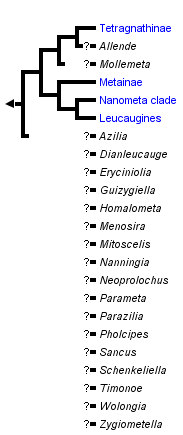


This tree diagram shows the relationships between several groups of organisms.
The root of the current tree connects the organisms featured in this tree to their containing group and the rest of the Tree of Life. The basal branching point in the tree represents the ancestor of the other groups in the tree. This ancestor diversified over time into several descendent subgroups, which are represented as internal nodes and terminal taxa to the right.

You can click on the root to travel down the Tree of Life all the way to the root of all Life, and you can click on the names of descendent subgroups to travel up the Tree of Life all the way to individual species.
For more information on ToL tree formatting, please see Interpreting the Tree or Classification. To learn more about phylogenetic trees, please visit our Phylogenetic Biology pages.
close boxIntroduction
The orb weaving spider family Tetragnathidae includes about 1000 described species in 51 genera (Platnick, 2009). The family is most diverse in the tropical regions and many species still remain unknown to science. Many tetragnathids are associated with some of the world's most important and fragile ecosystems, wetlands and river ecosystems, often building their orb webs very close to the water surface. Although many species live in relatively humid conditions, there are also others that thrive in dry climates. A good number of species are known from caves, such as many of the members of the genus Meta. Species in the genus Tetragnatha provide a striking example of dispersion abilities and ecological plasticity. With more than 340 described species and a distribution range that spans from the Arctic to the most remote oceanic islands Tetragnatha is one of the champions of the animal kingdom.
Characteristics
Most tetragnathid males have conspicuously enlarged chelicerae, often armored with numerous teeth. Some of these teeth, along with specialized cheliceral apophyses, play an important role during courtship and copulation as they are involved in a behavior known as cheliceral clasp (Bristowe, 1958; Eberhard and Huber, 1998). Other characters common to most tetragnathids are the close association of the embolus and conductor in the male palp, the presence of conspicuous trichobothria on the fourth leg femur and juxtaposed lateral eyes. Nevertheless, morphological features vary considerably within the family and there are several species that differ from the typical tetragnathid morphology. Females of the majority of tetragnathid genera have entelegyne genitalia, but the members of the subfamily Tetragnathinae provide a remarkable exception: all tetragnathines are secondarily haplogyne.

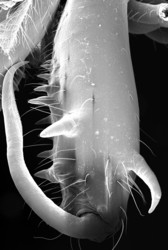
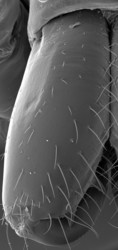
Tetragnatha javana. Left: male chelicerae frontal. Right: female chelicerae, frontal. Note the numerous teeth and cheliceral apophyses on the male chelicerae. Images © 2008 Dimitar Dimitrov
Most tetragnathids build orb webs of similar architecture, often with open hubs. Pachygnatha species have abandoned web building as a hunting strategy and actively search for food wandering around.

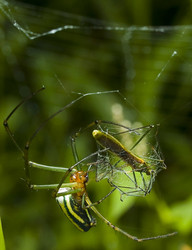
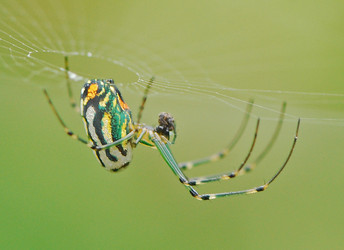
Two Leucauge species feeding in their webs. Left: Leucauge celebesiana. © 2007 Amir Ridhwan. Right: Leucauge venusta. © 2008 Jerry Oldenettel
Discussion of Phylogenetic Relationships
The first phylogenetic analysis of tetragnathids was that of Levi (1980) which did not recover Tetragnathidae monophyly, but his taxon and character sample was very limited. The first to demonstrate the monophyly of Tetragnathidae using numerical cladistic methods was Coddington (1990). He was also the first to suggest that tetragnathids are more closely related to other araneoid lineages than Araneidae. All subsequent cladistic analyses that included tetragnathid representatives have recovered the monophyly of the family. Earlier phylogenetic analyses of tetragnathids and their relatives relied heavily on morphological data and included a smaller fraction of behavioral characters (Coddington, 1990; Hormiga et al., 1995; Griswold et al., 1998). All these earlier studies included Nephila and its relatives in the tetragnathid subfamily Nephilinae, together with the genus Phonognatha. Kuntner (2005) elevated the subfamily Nephilinae to family rank and suggested that Deliochus and Phonognatha may not belong in Tetragnathidae. Later on Kuntner et al. (2008) formally transferred Deliochus and Phonognatha to the family Araneidae.
Recent and ongoing work on tetragnathids has further advanced our knowledge about the phylogenetic structure of this family. Álvarez-Padilla (2007) and Dimitrov and Hormiga (2009) have used extensive morphological and behavioral data to study tetragnathid phylogeny. More recently, Álvarez-Padilla et al. (2009) have added multigene DNA sequence data to the morphological and behavioral evidence. We present here the results of their study as the most current phylogenetic classification for Tetragnathidae. Álvarez-Padilla et al.'s (2009) study confirmed that Nephila and its relatives do not belong into Tetragnathidae (as it had been proposed by some earlier classifications, such as Eugene Simon's), but their exact phylogenetic placement remains unclear.
References
Álvarez-Padilla F., Dimitrov D., Giribet G., Hormiga G. 2009. Phylogenetic relationships of the spider family Tetragnathidae (Araneae, Araneoidea) based on morphological and DNA sequence data. Cladistics (In press).
Álvarez-Padilla F. 2007. Systematics of the spider genus Metabus O. P.-Cambridge, 1899 (Araneoidea: Tetragnathidae) with additions to the tetragnathid fauna of Chile and comments on the phylogeny of Tetragnathidae. Zool. J. Linn. Soc. 150: 285–335.
Bristowe W.S. 1958. The World of Spiders. Collins. London, xii + 304 pp.
Coddington J.A. 1990. Ontogeny and homology in the male palpus of orb-weaving spiders and their relatives, with comments on phylogeny (Araneoclada: Araneoidea, Deinopoidea). Smithson. Contrib. Zool. 496: 1–52.
Dimitrov D., Hormiga G. 2009. Revision and cladistic analysis of the orbweaving spider genus Cyrtognatha Keyserling, 1881 (Araneae, Tetragnathidae). Bulletin of the American Museum of Natural History 317: 1-139.
Griswold C.E., Coddington J.A., Hormiga G., Scharff N. 1998. Phylogeny of the orb-web building spiders (Araneae, Orbiculariae: Deinopoidea, Araneoidea). Zoological Journal of the Linnean Society 123: 1–99.
Hormiga G., Eberhard W.G., Coddington J.A. 1995. Web-construction behaviour in Australian Phonognatha and the phylogeny of nephiline and tetragnathid spiders (Araneae: Tetragnathidae). Aust. J. Zool. 43: 313–364.
Eberhard W. G., Huber B. A. 1998. Courtship, copulation and sperm transfer in Leucauge mariana (Araneae, Tetragnathidae). Journal of Arachnology 26: 342-368.
Kuntner M., Coddington J.A., Hormiga G. 2008. Phylogeny of extant nephilid orb-weaving spiders (Araneae, Nephilidae): testing morphological and ethological homologies. Cladistics 24: 147-217.
Kuntner M. 2005. A revision of Herennia (Araneae, Nephilidae, Nephilinae), the Australasian ‘coin spiders’. Invertebrate Systematics 19(5): 391–436.
Levi H.W. 1980. The orb-weaver genus Mecynogea, the subfamily Metinae and the genera Pachygnatha, Glenognatha and Azilia of the subfamily Tetragnathinae north of Mexico (Araneae: Araneidae). Bull. Mus. Comp. Zool. 149: 1–75.
Platnick N.I. 2009. The world spider catalog, version 9.5. American Museum of Natural History, online at http://research.amnh.org/entomology/spiders/catalog/index.html
Simon E. 1894. Histoire naturelle des araignées. Paris, 1: 489-760.
Information on the Internet
- Alvarez-Padilla, F. and G. Hormiga. 2009. Key to the genera of the family Tetragnathidae (males). Review version 1.0. Key to the genera of the family Tetragnathidae (males)
- Alvarez-Padilla, F. and G. Hormiga. 2009. Key to the genera of the family Tetragnathidae (females). Review version 1.0. Key to the genera of the family Tetragnathidae (females)
- Alvarez-Padilla, F., D. Dimitrov, and G. Hormiga. 2009. TetraGen: Tetragnathid Genera of the World (Araneoidea: Tetragnathidae), An Illustrated Catalog. Pre-release version 1.0. The George Washington University, online at http://www.gwu.edu/~spiders/tetragen/index.cfm
- A nice collection of illustration of some tetragnathid type species and other orb weavers by Herbert W. Levi can be found at http://www.oeb.harvard.edu/faculty/levi/
Title Illustrations

| Scientific Name | Leucauge decorata |
|---|---|
| Location | Batu Pahat, Malaysia |
| Comments | Leucauge decorata seen on a hill i Batu Pahat. This is the first Leucauge spider I encountered and the very one that inspired my journey to discover more of its kind. |
| Specimen Condition | Live Specimen |
| Source | L. decorata |
| Source Collection | Flickr |
| Image Use |
 This media file is licensed under the Creative Commons Attribution-NonCommercial-NoDerivs License - Version 2.0. This media file is licensed under the Creative Commons Attribution-NonCommercial-NoDerivs License - Version 2.0.
|
| Copyright | © 2007 Amir Ridhwan |
| Scientific Name | Tetragnatha sp. |
|---|---|
| Location | Madagascar |
| Specimen Condition | Live Specimen |
| Identified By | Dimitar Dimitrov |
| Image Use |
 This media file is licensed under the Creative Commons Attribution-NonCommercial License - Version 3.0. This media file is licensed under the Creative Commons Attribution-NonCommercial License - Version 3.0.
|
| Copyright |
© 2009 Gustavo Hormiga

|
About This Page
Dimitar Dimitrov

Zoological Museum, University of Copenhagen
Gustavo Hormiga

George Washington University, Washington, D. C., USA
Correspondence regarding this page should be directed to Dimitar Dimitrov at and Gustavo Hormiga at
Page copyright © 2009 Dimitar Dimitrov and Gustavo Hormiga
 Page: Tree of Life
Tetragnathidae .
Authored by
Dimitar Dimitrov and Gustavo Hormiga.
The TEXT of this page is licensed under the
Creative Commons Attribution-NonCommercial License - Version 3.0. Note that images and other media
featured on this page are each governed by their own license, and they may or may not be available
for reuse. Click on an image or a media link to access the media data window, which provides the
relevant licensing information. For the general terms and conditions of ToL material reuse and
redistribution, please see the Tree of Life Copyright
Policies.
Page: Tree of Life
Tetragnathidae .
Authored by
Dimitar Dimitrov and Gustavo Hormiga.
The TEXT of this page is licensed under the
Creative Commons Attribution-NonCommercial License - Version 3.0. Note that images and other media
featured on this page are each governed by their own license, and they may or may not be available
for reuse. Click on an image or a media link to access the media data window, which provides the
relevant licensing information. For the general terms and conditions of ToL material reuse and
redistribution, please see the Tree of Life Copyright
Policies.
- First online 23 January 2009
- Content changed 09 March 2009
Citing this page:
Dimitrov, Dimitar and Gustavo Hormiga. 2009. Tetragnathidae . Version 09 March 2009 (under construction). http://tolweb.org/Tetragnathidae/2799/2009.03.09 in The Tree of Life Web Project, http://tolweb.org/




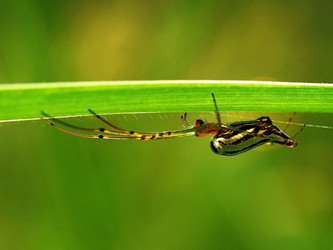
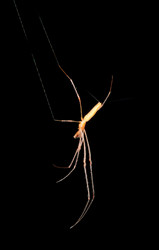
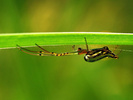


 Go to quick links
Go to quick search
Go to navigation for this section of the ToL site
Go to detailed links for the ToL site
Go to quick links
Go to quick search
Go to navigation for this section of the ToL site
Go to detailed links for the ToL site